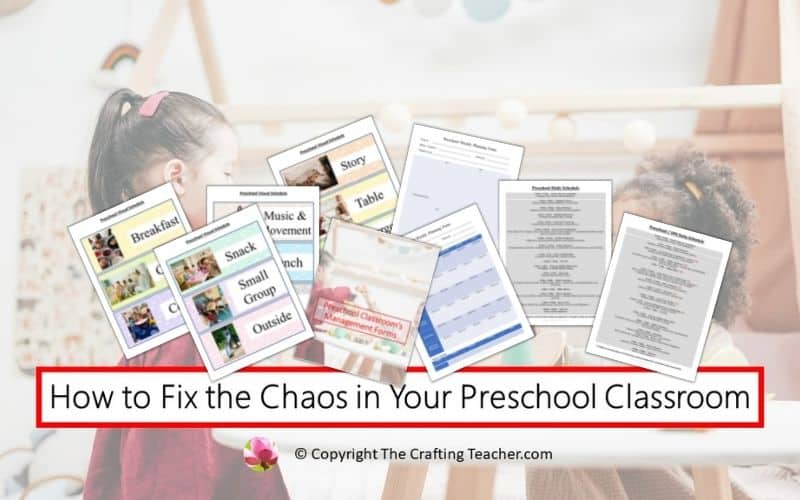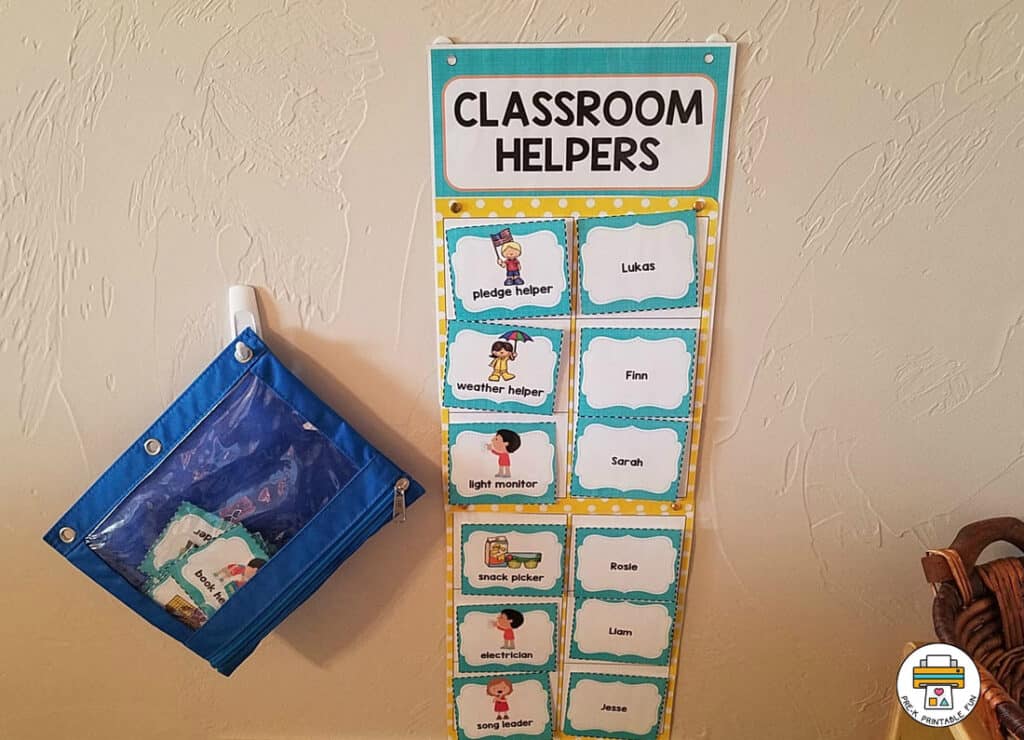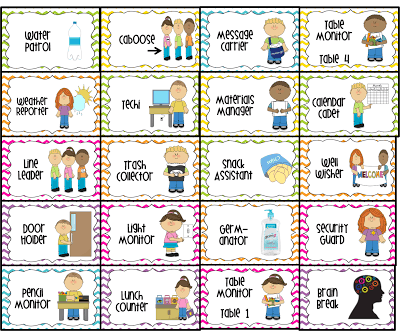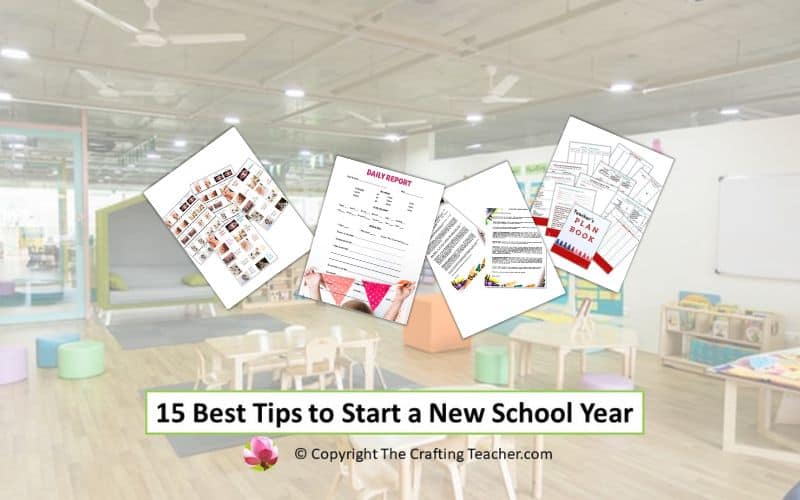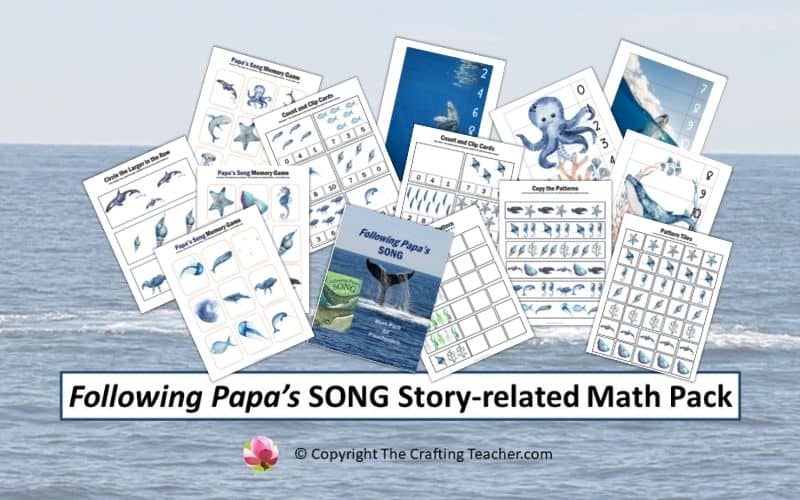How to Fix the Chaos in Your Preschool Classroom
Have you ever gone to a preschool program and noticed that children in some classes are quiet and engage and the class seems organized, but there are other classes where children are screaming to the top of their lungs, there are toys everywhere and the teacher looks like she’s losing her mind?
Yeah! I’m sure you have. Unfortunately, this chaos is probably caused by the lack of a good management system that should’ve been put in place from the beginning of the school year.
In my years as a preschool director, I have seen how many new preschool teachers struggle to keep their children engaged and interested to maintain a good learning process and an organized environment.
Unfortunately, once you lose the attention of your preschoolers or fail to plan activities that will keep them actively engaged, it is very hard to rein them back and avoid chaos.
The secret behind an organized classroom where children seem happy and eager to learn and where teachers can deliver their planned activities easily to create a positive learning environment has to do a lot with the classroom management plan they have in place.
But let’s start at the beginning and let me explain to you what I mean by classroom management if you don’t understand what I’m talking about.
What is a Classroom Management Plan?
In general, a classroom management plan is a strategy that establishes in detail which are the rules and procedures that a teacher is going to use in her class, to create an environment where mutual respect and learning are the priority.
For me personally, is more about the culture and environment that a teacher creates in her classroom and has to do with her connection to her preschoolers, the set of rules she establishes with them, her personal reactions to the actions and behaviors her children display, and how she organizes her classroom, materials, and lesson plans with defined guidelines in mind to support positive behavior in her preschool classroom.
I am not going to lie and say that it is easy. It is not! Raining easily distractive preschoolers requires a LOT of patience, the creation of boundaries, being aware of what is happening in your classroom AT ALL TIMES, good timing, and instinct.
A classroom with a good management plan normally provides a balance between active learning and passive learning.
Active learning happens when you are doing activities such as:
- music & movement
- outside time
- center time
Passive learning happens when you are doing activities such as:
- storytime
- water and sand table
- puzzles
It is good not to have activities of the same type back to back. Too many passive activities might cause your children to feel bored. On the other hand, too many active consecutive activities will cause your children to stay too excited. Both cases may promote your children to misbehave.
The best way to go is to have a good balance between both types of activities and switch things around to keep your children interested and engaged but controlled. Also, preschool teachers have to establish very clear behavior expectations, communicate them to the children and enforce them kindly and consistently.
Best Guidelines for a Good Management Plan
Develop Classroom Rules
These rules should be created with your students, to make them accountable. They must be simple and short and must focus on expected behaviors such as:
- “Use walking feet”
- “Use listening ears”
- “Respect each other”
- “Use gentle hands”
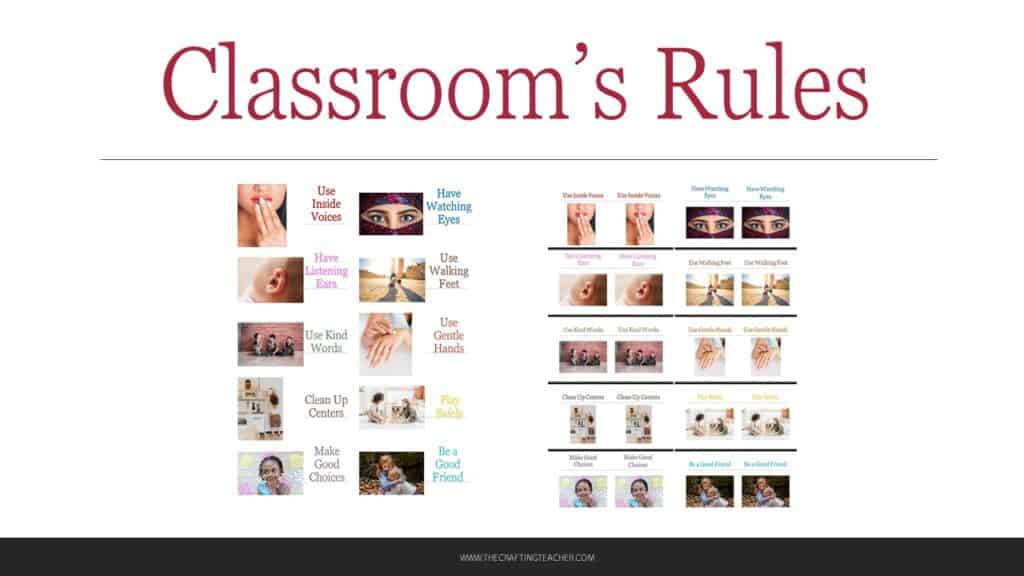
Be Specific
These are an extension of the rules, to make them clearer. They should be reviewed every day during circle time, and when it’s needed according to what happens in your classroom during the day. These can be defined as:
- “We use walking feet inside the school to be safe”.
- “We use listening ears to be able to learn”.
- “We respect each other because….”
- “We use gentle hands so we don’t hurt our friends”.
Be Consistent
Preschoolers need routines to thrive. They need to know what is expected from them and what they can expect to happen that day; otherwise, they will be confused, will not know what to do and chaos will set in. I’m not saying that sometimes you need to be flexible and change your routine a little bit to accommodate something important, like a special visitor to your classroom or use an un-planed teachable moment when it presents itself (like this week when I have to take out of the playground a snapping turtle on Wednesday, a bat on Thursday and another turtle on Friday (twice!). Some of the things you can do are:
- Have a set daily visual schedule, because your preschoolers don’t know how to read yet. It is good practice to talk about the schedule and what activities you planned for each section. This should be a set schedule. That means it has to be the same every day. The one below is a FREE visual schedule that is ready for you to use. Print it in white cardstock, cut out the pictures, and laminate it, to make it last. You can place them on the wall and use your favorite arrow to mark what part of the day you are now. Just click on the link below to grab it.
- Have a sign-in station for your children. This is an example you can use.

- Assign classroom jobs that are rotated every week. This will give your students a sense of belonging and importance, and believe me, preschoolers take their jobs very seriously.
Use Visual Cues
Since preschoolers do not read yet, you must use pictures everywhere to guide them. Some places where you can use labels with pictures are:
- Your centers’ baskets so your preschoolers can clean up by themselves.
- The bathroom, to show them the hand-washing steps.
- Next to the door, to show them how to line up.
Another type of cue that always worked for me was auditory cues. One of the things I liked to do was say “One, Two, Three, Eyes on Me” when a wanted to call their attention.
Remember that consistency is the key; therefore, choose the cues you want to use and be consistent, to make it part of your routine.
Manage Transitions
Most problems occur during these periods. Transitions should be smooth and short. It is good the give children cues when the activity is going to change, either to go outside, eat, or simply start the next activity.
There are several things you can do such as:
- Play a piece of special music or a countdown from 10 to 1 to help them get ready for the transition.
- Use a timer to mark when an activity is going to change.
- Give an auditory cue when it’s time to clean up. A good song to use is this one.
Whatever you do, be prepared and always have an option for something to do. Improvisation tends to be food for chaos.
Reinforce Good Behavior
Preschoolers love to be praised (like everybody else). Instead of focusing on the bad behaviors, it is a good practice to focus on positive interactions, because negative attention reinforces negative behaviors, and that’s exactly what you want to avoid. However, it is a good practice to pay close attention because sometimes the bad behaviors are rooted in problems at home, trauma, lack of attention or communication at home, and other situations that a child should not go through. In this case, ignoring what is happening with that specific child could cause more problems because it will make him feel more alone and lost, and will reinforce the bad behavior instead of correcting it.
Encourage Social Skills
Social skills are not ingrate in children. They must be taught, and sometimes the only place where preschoolers can learn social skills such as being kind, caring for others, and being respectful in your classroom. Some of the things you can do to encourage the development of these skills are:
- Give mini-lessons on positive behaviors like sharing toys, keeping their hands to themselves, and using gentle hands. A good time to do this is circle time.
- Read books about recognizing and managing feelings.
- Encourage them to work together in pairs or groups.
- Show them positive behaviors by doing it yourself.
Pay Attention
When you take the time to listen to what your preschoolers have to say you make them feel that you care. This practice not only promotes your children to develop their vocabulary and emotions’ self-regulation, but also helps them grasp math concepts, letters, and sight words better.
Most of the time preschoolers do not know how to tell you what they are feeling or why. You must help your children manage their emotions by being understanding and offering two positive options like “I can see that you are not feeling very good right now. Do you want to go to the quiet area or the sand table until you are ready to come back to the group?”
Be Aware
Most of the time the behavioral problems occur around the same time of the day. Take note of this to find out if you have to change something in your routine that might be promoting these behaviors, but remember that prevention is always better. A good way to do this is to pay attention to what is happening in your classroom, at all times.
Involve Parents
Good communication is essential in the preschool classroom. Keeping families in the loop will allow them to get involved (and help you), not only academically but also with behavioral problems. Remember that these types of behaviors are just a “cry for help” from your preschooler. The child is trying to communicate something and it’s your job to try to find out what it is, to be able to help him or her.
Set Up Well-Defined Areas
It is important to organize your classroom in a way that promotes effective learning. A good practice is to separate active play (noisy) areas like block & housekeeping centers from passive play (quiet) areas like library and art centers. It is also a good practice to limit the number of children in each area.
Be Organized
When you use the lesson plans you are preparing for your day EVERY DAY, your classroom will run smoothly. Children notice when you are lost and unorganized and they take advantage of it; on the other hand, they do appreciate order and routines. It gives them security and stability. I also recommend planning a couple of extra activities every day, in case something you planned doesn’t work. Remember that if you keep your children interested and engaged, they will not have time for challenging behaviors.
This is an example of a weekly planning form and is completely FREE for you to use. Just click on the link below to get it.
As I said before, it is also important for you to have a good schedule. When you don’t know in what order you need to plan your day, you are going to be changing the routine every day and will feel lost and confused. Children notice this and pick up on those feelings. Remember that an unorganized classroom is a perfect ground for chaos.
These are a couple of FREE schedules, just to give you an idea. One is just for preschoolers and the other includes the VPK hours. Feel free to use them as is or just as examples for you to create a schedule that is more convenient for you and your preschoolers. Just click on the link below to grab them.
To help you remember these guidelines, here is a FREE infographic. Just click on the link below to download it.
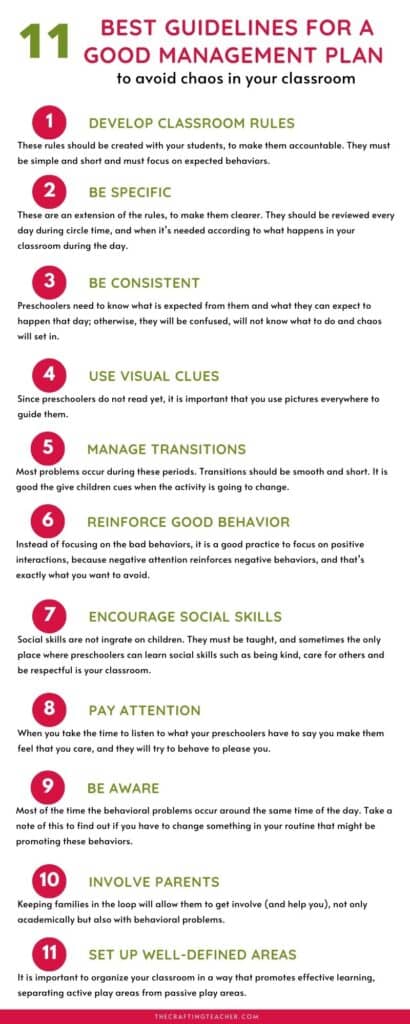
Conclusion
A good classroom management plan is basically about the planned strategies you have established for your classroom. Things are always different and evolving in the preschool classroom, and what works for you the previous year or even the day, might not work as well the next one.
Pay close attention to the needs of your children and notice when they need guidance, but also when you need to take a step back and let them figure out things by themselves, to allow them to experience and increase their social-emotional development.
Ask more experienced teachers for advice. They might have a “trick up their sleeve” that you can try in your classroom and see if it works for you.
Being a preschooler’s teacher can fill your life with stressful moments, but also with laughter, happiness, love, and satisfaction. Your children will follow your lead and if they see you are enjoying the process, they will enjoy it as well, producing a better learning environment.
Most importantly, remember that what worked one day might not work the following day. Sometimes even a child being absent could be the difference. Don’t try to make yourself perfect. Nobody is expecting you to be, but be fully present, warm, and approachable to your students and their families, to create a school family where you all trust, help and respect each other.
Once you accomplish this, the rest will come. Good luck!
Be happy, safe, and creative. I wish you well.
Love,

P.S. If you like these ideas please share them, and let me know if you tried some of these techniques and how did it go, or if you have any other ideas that might be useful, so I can update this post with them.

